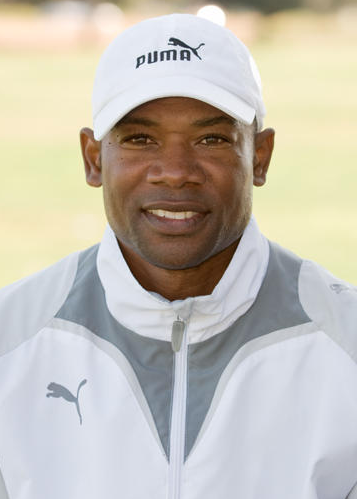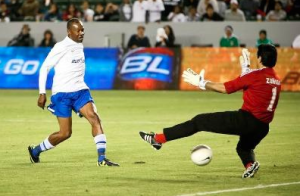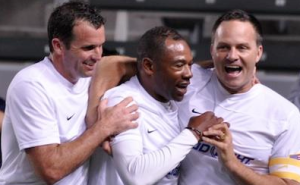Lassiter Brings Dedication and Knowledge to the Pitch
San Diego’s Albion SC brought in former MLS star Roy Lassiter in 2009.Lassiter is an amazing coach and is dedicated to developing his players … and as a player he still scores big. Lassiter scored the first goal for the USA in the Legends Cup against Mexico.

Roy Lassiter exploded on the professional soccer scene in 1996 when he scored a still-record 27 goals in one season in Major League Soccer (MLS) with the Tampa Bay Mutiny. But even before then Lassiter had been on the soccer radar, with standout seasons at North Carolina State University and a U.S. Men’s National Team career that began in 1992.
These days Lassiter coaches at Albion SC in San Diego, where he is also Director of Advancement. From his youngest days in Washington D.C., through college and his professional career, Roy Lassiter has always been both a top player and a dedicated student of the game.
Few players or parents realize Lassiter’s background so Soccer Nation thought we would write a special spotlight on this amazing former professional player – now youth soccer coach. Lassiter is a modest man, not one to brag or grab the limelight, but one deserving of recognition.
Lassiter was born in the Nation’s capitol, but grew up in North Carolina where he played basketball and baseball in addition to soccer from the age of five at the Boys Club and YMCA. While he never got the type of coaching that players get at a young age today, he benefitted from having two coaches in particular who had a true passion for the game – one from Nigeria and another from Yugoslavia. That passion helped to inspire the budding star.
When he was about ten years old, Lassiter found himself being scouted and recruited by a Select team from the area. “At that time I didn’t even know what ‘Select’ was,” he admits, but that didn’t stop him from taking advantage of the opportunity to develop his game even more.
While all of this was pushing Lassiter on the pitch, the real spark came from a neighbor, who just happened to be a coach at North Carolina State. “The coach at NC State at that time lived two houses down from me,” Lassiter explained, “and he took me as a ball boy. I saw amazing soccer and I saw passion within the people and among the players, and I just started liking it even more. It just snowballed from there and I kept wanting to play.”
Soccer became an everyday part of Lassiter’s life. “I found myself playing with a soccer ball every single day with my brother,” he said. “He was my closest and strongest competitor and probably made me what I was when I was a professional. I was just on the ball all the time and things just started to happen.”
In high school Lassiter was an All-American while at Athens Drive High School and in his senior year he was North Carolina State 4-A Player of the Year. That same year he led his school to the state championship, scoring a record 47 goals in competition. For his successes, he was offered several full scholarships to college, deciding on the College of Charleston in part because he admired the head coach.
Lassiter played on the varsity as a freshman that first year, scoring 13 goals, but decided not to continue at the school for personal reasons. “I didn’t really like the school,” Lassiter explained. “I felt too far from my family my first year of college. I thought it was going to be okay, and I liked the coach at Charleston – he was a great guy, a very Christian-type coach and I really liked him,” but it was not the right environment for him. Ultimately Lassiter transferred to North Carolina State, where he finished out his college career.
In 1992 Lassiter was signed by AD Carmelita of Costa Rica and spent the next several years playing with various teams in that country. In 1995-1996, while playing with LD Alajuelsense, Lassiter was named Foreign Player of the Year. Then the MLS came calling.

Lassiter signed with MLS for the league’s inaugural season and was allocated to the Tampa Bay Mutiny. That first season, playing beside the likes of Carlos Valderrama, Lassiter scored his record 27 goals. He went on to play a second season with Tampa Bay before moving to D.C. United for two years. He also played with the Miami Fusion and the Kansas City Wizards before his MLS career was over.
During this time Lassiter was also playing with the National Team, earning 30 caps and scoring four goals between 1992 and 2000. His first goal was also the winning strike in a 4-3 friendly win against Saudi Arabia in October, 1995. His second goal was also an eventual game winner in a 2-1 1998 World Cup qualifier against Costa Rica in December, 1996.
While coaching was not part of his original plans, Lassiter had always been a strong student of the game and an excellent communicator, and the evolution was natural. In 2005 he joined Austin United Capitals in Texas as the club’s Director of Coaching. It was while coaching there that he first came into contact with Noah Gins, Director of Coaching at Albion Soccer Club in San Diego.
Every year Gins takes a group of players to Brazil, and one of the boys on Lassiter’s team that year had caught his eye. “I was at Surf Cup with my team back in ’08 and I got a call from Noah. I guess he had seen my team play and seen my son play and he inquired about one of the players on the team.” Lassiter remembered. At the time Gins did not know that the young standout was Lassiter’s son Arial.

“We kept talking and I finally told him that Ariel was my son, and from there we just kept talking,” said Lassiter. The two coaches soon found that they had much in common in their philosophy and methodology. Gins brought Lassiter out to San Diego to observe and participate in a few training sessions.
“We just kept talking and all of a sudden Noah just made it happen,” Lassiter recalled. “I left Austin, Texas, and came to work for Albion.”
Coaching has changed by leaps and bounds in the years since Lassiter was a youth in YMCA. While it was still competitive, back then it was much less structured than it is today. He recalls that he never had a truly experienced coach until he was about eleven years old. “It probably wasn’t as ruthless as it is today,” admitted Lassiter, pointing out what sometimes becomes over-involvement by parents and board members in the daily running of clubs and teams.
“I know that’s hard, and I know parents want to be so involved in what the kids are doing – and they should be involved, but to a point,” said Lassiter. “I think a lot of them over-influence and they don’t let the coach and the player really understand each other.”

Lassiter sees that understanding between coach and player to be an important element in development. He believes that players need to feel comfortable and confident enough to go to the coach for advice on their playing ability.
Unfortunately, when parents are over-involved in the player’s development it inhibits that understanding. Parents take over the communication, occasionally interpreting things differently than the player might. Then the parent decides to take the player to a different club rather than allowing the child to work things out on his or her own.
“I think we get too many people who are extremely involved and then it becomes very political,” said Lassiter. “Decisions are made at that point that are not in the best interest of the player, which is the wrong way to go. It should always be in the best interest of players.”

What has changed for the better is the level of coaching players get, even at the earliest ages. “The kids are having better coaches now,” Lassiter explained, “and coaches are teaching players the fundamentals of the game earlier and knowing the importance of that.”
Lassiter believes that the goal of the coach should be to help players develop the skills and abilities they need to take their game as far as they possibly can.
Rather than the emphasis on winning, which he sees all too often, the focus should be on developing the tools players can use when they move into high school and college, or even on to a professional career. “I think if they had the tools that could help them go on to that next level, they would be better off,” he said.
In order to help players develop both the tools they need and the passion for the game that will propel them to the next level, Lassiter presents an annual summer camp.
In these camps, Lassiter provides a less-structured environment where there is an emphasis on creativity and playing for enjoyment as well as success. To help participants make the same passionate connection he had growing up, Lassiter invites former teammates and other soccer greats to his camp.

“Every camp I’ve had I bring in a World Cup player because I need players to be able to relate,” said Lassiter, who brought LA Galaxy forward Edson Buddle to the 2012 camp. “I think having players like Cobi Jones, Frankie Hejduk, Chad Deering, Mia Hamm and Edson Buddle come out to be involved in your camp will help players start to decide what they want to do.”
Throughout his career, Roy Lassiter has proven himself a winner both as a player and a coach. With his dedication, skills and connections, Albion has one more reason to stand proud.







